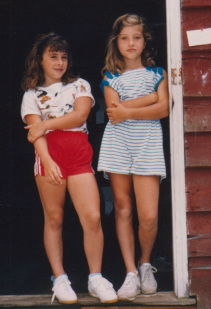discipleship
in chaos
Learn more about who we are by following our blog, written by our pastor, preacher, and chief evangelist. Engage in the everyday sacred as Abby writes about the deep and ordinary all at once.
Yet never before, together, as a friendship, have we so desperately needed God to hold not just the world, but us, in agapic love.  Just last week my childhood friend Kimmy was diagnosed with Acute Myeloid Leukemia while she was 35 weeks pregnant with her third child. Kimmy and I have been best friends since we were both placed in Mrs. Durney’s 2nd grade class. We became friends as a result of happenstance, yet God has transformed our friendship over the past thirty years from childhood chance into something holy other. I wondered, however, as I spent three days with my dear friend on an oncology unit just how that transformation occurred. I wondered how I could count the three days I spent with Kimmy as toxic chemo, pasty platelets, and vivid red blood cells dripped into her blood stream as blessed. I wonder how those three days, which left me utterly exhausted and heartbroken, were deeply holy. What else are you supposed to do when you learn your childhood friend has been diagnosed with Leukemia and must give birth in order to save her life? You show up. (Note to reader: I am no saint. I did what everyone would do.) I coordinated with her sister, arriving after the initial wave had settled down. Her baby boy was safe and sound in the hospital NNICU and my friend was hooked up to chemo. I brought scarfs and haircutting scissors, advice from others who had gone through cancer treatments and prayers rocks. I also brought knitting, because what is one to do? I assumed I would sit by her bed and knit. I did knit, but I didn’t do a lot of sitting by her hospital bed. Mostly I spent the days lying beside Kimmy in her bed, cuddled next to her, watching her 5 pound baby boy on the TV screen (hospital IT guys connected a live feed to her TV set). We talked and we talked like we always have. We shared stories of our children. We spoke openly of our fears. We tried to plan for her children’s upcoming weeks without her. We mourned her lost summer plans: working with her eldest on reading, teaching the girls how to swim, nursing her newborn. We wept. We laughed. We shared our lives. Perhaps my husband said it best, “You and Kimmy are like twin sisters.” Maybe we are. Maybe the holiness of our relationship has to do with an intertwined past. But if that were the answer wouldn’t all childhood friendships swaddled in sweet memories mature into deep relationships? Perhaps God knew we would need one another, but don’t all people need abiding friendships? I have come to one overly simple conclusion. I believe our friendship moved from blessed to holy on that oncology unit because we continued, as we always have, to share our lives openly and honestly with one another. Yet this time, we did it with full awareness that God, as God always has been, was the third friend listening. Kimmy and I share a common faith. We both view the world as a place tenderly held in God’s love. Yet never before, together, as a friendship, have we so desperately needed God to hold not just the world, but us, in agapic love. We were held. Kimmy is not cured. Nothing is okay in her day to day life. My visit certainly did not heal her. Yet our visit with each other somehow, reminded us in a new and profound way that God is ever so close. For the heck of it, a timeline that made me feel better to record: 1984: K & A spend every weekend at each other’s house 1986: K & A go to different schools but remain best friends 1988: K & A begin wearing matching half-heart bbf necklaces 1994: K & A attend each other’s high school graduations and have sorrowful goodbye’s before the first day of college 2001: K & A both get married and stand up in each other’s weddings July 2013: Kimmy is diagnosed with Acute Myeloid Leukemia while she is 35 weeks pregnant with her third child.
1 Comment
 My husband ordered special burgundy duct tape for our burgundy minivan. Why? Our minivan over the past ten years has collected some major exterior rust spots, or shall I say holes. My beloved very carefully, and may I add proudly, covered up these holes with his special order duct tape. He likes to show everyone who comes to visit his handiwork. Clearly, automotive aesthetics are not a high priority in our home. So why did my husband bother covering the holes? Our van did not pass its most recent state inspection because it had exterior rust holes. Shocked, I asked the garage owner what this had to do with anything. “Is the axle rusting or something?” Patiently, my mechanic explained that it is a more recent standard: children could cut their fingers on the rusty spots. The holes had to be covered or fixed for our van to pass inspection. Hence, special order burgundy duct tape, back to the garage, inspection sticker procured. My husband is still proud of his duct tape fix, but I’m a bit frustrated that there is a new rule that cars can’t have rust holes in Massachusetts. As a culture we are obsessed with safety. On one hand this is a great thing: children suffer from less head injuries now because everyone wears bike helmets. On the other hand we seem to be anxiously pursuing a perfectly safe world in which no child ever heads to urgent care for a few stitches after stupidly shoving their finger in a rusty car hole. Perfect safety? Not possible. A childhood without a few minor injuries? Not possible. Perfect health, perfect house, perfect wedding, perfect relationships? Not possible. A life without some struggle, heartache, trips to the doctors? Won’t happen. I wonder if this new law in Massachusetts concerning rusty cars is really an unconscious pursuit of a life without suffering. I know this seems like a big leap, but I’m not sure it is. We live in a world of helicopter parents, every diagnostic test under the sun, and endless magazines talking about how to create the perfect fill in the blank. It’s as if we want to order the chaos of life, control the dangers of living, and finally wrap everyone in bubble wrap to ensure a life without, well, suffering. Suffering is a part of life in this terribly beautiful world. Yet suffering is often a place where God’s presence becomes palpable. It is the tunnel through which we pass and, if we suffer wisely, come out changed. It can refine our characters, open our hearts, and deepen our compassion. Suffering makes souls. If Massachusetts really thinks there should be no cars with rusty holes, so be it. But I refuse to believe that any number of laws can keep me or those I love safe in this world. Suffering is a part of living. And the only true safety I have ever found is trusting our God who numbers the hairs on my head. (Luke 12)  I went to a Mother’s Day tea at my son’s Montessori school. It was the usual delightful event—finger sandwiches spread thick with butter by little hands, tea poured ever so carefully by the older children, and handmade presents. I look forward to this tradition every year. This time, however, we did something different. At the close of the tea, children and their mothers gathered in a circle and shared in a peace walk. The peace walk is a “work” that the children can choose to do as part of their day. It’s very simple: the children gather in a circle around a peace lily and take turns walking around it while holding a small flower. When they are done with their walk they hand the flower to someone else who then takes a turn walking, gently and quietly, around the lily. This goes on until all the children have a turn. As I watched beautiful children walk carefully around the lily, each with their mother next to them, I was moved to tears. Why was this very simple act so peace-filled? And why is peace so difficult for adults, but so effortless for children? I am not sure how to even write about peace. I know a few things about peace, like there can be no peace without justice and that peace takes active work to achieve. I know that love and generosity accompany peace. I also know too much about the opposite of peace: poverty, violence, injustice, addiction, broken relationships, and more. Yet these challenges seemed irrelevant as I watched mothers and children walk in a circle. Great thinkers and leaders have dedicated their whole lives to understanding and creating peace. You can earn a masters degree in peace studies at some universities. Yet here, in a seemly insignificant school, children taught their mothers about peace without any words. Isaiah 11 depicts a powerful image of peace where wolves and lambs lie next to one another and justice is central. Near the end of the vision the poet concludes, and a little child will lead them. I have nothing new, nothing articulate, nothing profound to say about peace. But I now understand why Isaiah said a child shall lead. Children understand the powerful simplicity of peace. That, I am certain, is why I was moved to tears as I watched child after child circle a lily and why, in that brief moment, I was sure peace was not an idea but a reality. |
Abby HenrichRev. Abigail A Henrich (ehm!) is an ordained minister who earned her stripes at Princeton Theological Seminary and Colgate University. That said, Abby is really a mother-pastor-spouse who lives in a kinetic state of chaos as she moves from her many vocations: folding laundry, preaching, returning phone calls, sorting lunch boxes, answering e-mails, and occasionally thinking deep thoughts in the shower. Unabashedly she is a progressive Christian who believes some shaking up has got to happen in the church. Categories
All
Archives
March 2024
|